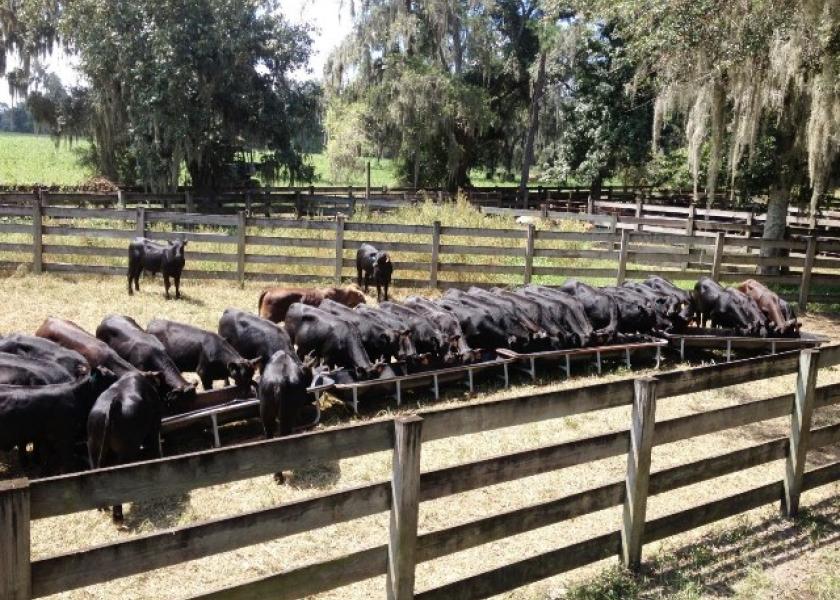Opportunities for Growing Cattle on Self-Fed Rations

We are faced with conditions where it will likely be very valuable to buy or retain calves this fall to sell as feeders next spring. Lack of wheat pasture and cost of hay and feed have priced most of our normal production systems out of the market. Some other options that should be considered include using low quality products from grain, cotton, or peanut processing as roughage replacements in self-fed rations.
Products like cotton gin trash, peanut hulls, or rice mill feed may be locally available or have the potential to be shipped in at a low enough price for these to be viable options for growing calves or wintering beef cows. Rice mill feed is a blend of 67% ground rice hulls and 33% rice bran from the rice milling industry. Gin trash is made up of cotton leaves, seed, immature bolls, stems, and lint from the cotton ginning process. Peanut hulls are the shell of the peanuts removed during processing. All of these are high in fiber and can be extremely variable in composition and nutrient profile.

Self-feeding rations composed of rice mill feed and corn or rice mill feed and soybean hulls along with free-choice hay offered separately showed some promising results for growing calves. Research from Alabama in 2004 showed that growing steers fed a blend of 60% rice mill feed and 40% corn gained over 2.2 pounds per day and consumed nearly 22 pounds of feed and 3 pounds of hay per day. These dry matter intakes were over 3.3% of their bodyweight. As corn replaced more rice mill feed gains and intake of feed increased but hay intake decreased.
Feed efficiency in this system were from 8.3 to 11.1 total pounds of feed and hay per pound of gain for the 40/60 rice mill feed/corn and 60/40 rice mill feed/corn blend, respectively. When soybean hulls were used as the energy source in similar rations, steers fed 70% rice mill feed and 30% soybean hulls consumed over 26 pounds of the feed and 4 pounds of hay on a dry matter basis, this equated to over 4.5% of bodyweight in daily dry matter consumption. Steers on the 70% rice mill feed diet gained 2.2 pounds per day, and as more soybean hulls replaced rice mill bed feed intake and average daily gains increased but hay intake decreased.
Similar research from Alabama in 2008 used peanut hulls and cotton gin trash as roughage replacements in self-fed rations. These diets included either 45% peanut hulls or cotton gin trash along with cracked corn at 55% or with 47% cracked corn and 8% cottonseed meal.
The peanut hull/cracked corn diet was slightly deficient in protein which impacted both intake and performance, but steers still had daily fed and hay consumption rates over 3.3% of body weight and gained 1.9 pounds per day. Steers fed the peanut hull diet containing added protein from cottonseed meal consumed feed and hay at 3.7% of bodyweight and gained 2.25 pounds per day. Steers fed the gin trash diets consumed over 4% of their bodyweight daily and gained over 2.5 pounds per day.
- We normally do not expect growing steers consume over 2.5 to 3% of their bodyweight, but intakes over 3.3 to 4% of bodyweight are often observed in self-fed byproduct-based diets.
- Feeding a palatable moderate quality hay is essential for rumen health especially for the ground byproduct-based diets.
- These feeding systems have potential for use in cows, but the high intake of these diets can be cost prohibitive. So, a higher inclusion rate (60 to 80%) of rice mill feed, gin trash, peanut hulls, or other byproducts should be considered. Also, self-feeding should be time limited or physical barriers to limit access be put in place (such as lowering the door on the self-feeder) to limit intake.
- These feeding programs are most efficient and cost effective if on farm feed mixing and delivery can be implemented and truckload lots of bulk commodities can be sourced and stored on-farm.
- Contact your local Cooperative Extension office for assistance in developing and managing feeding programs to fit your operation.
Dr Derrell Peel discusses the impact of drought and lack of wheat pasture in the state on the stocker cattle markets from SunUp TV from October 15, 2022. https://www.youtube.com/watch?v=F44zrBUcI0Q







